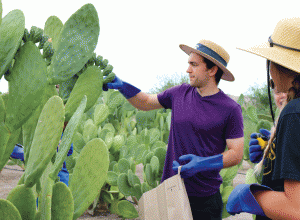By JENNA RHUDE
Moapa Valley Progress

Most folks drive past this exquisite garden every day without even noticing it. But the cactus garden growing behind the Logandale University of Nevada Cooperative Extension office is truly unique.
Dr. John Cushman brought his team of grad students to this garden last week to harvest ‘tuna’ from the cacti. Tuna is the fruit that grows from the Opuntia pad, or Prickly Pear Cactus. The fruit reaches maturity once a year.
However, the team from University of Nevada, Reno (UNR), was not here to harvest ripe fruit for eating. Instead, the group, spent three days cataloging and harvesting all the fruit from every pad. They were assisted by a number of local teens acting as Conservation Aides.
Minding the spines, the students wore gloves and used tongs to remove the tuna. The spines, or glochids, are tiny barbed hairs that like to find their way into clothes and skin. While taking precautions, the safety measures are not always fool-proof, and some itchiness is inevitable.
Recent MVHS graduate Gavin Henrie said that he was glad to be a Conservation Aide for the project. “I learned that cacti can be used for fodder for animals,” Henrie said. “Just one fascinating fact I did not know before.”
The tuna collected will be weighed and catalogued by the UNR team to help determine the best irrigation and environment needed for the plants to flourish.
Cushman said he would like this study to show that cacti are a good alternate option for biofuel. “Right now we get biofuel from corn and soybeans,” he said. “We want to be able to utilize the entire country for food/biofuel production.
“Also, with global warming it’s important to find a plant, such as cacti, that is heat and drought resistant,” Cushman added. “Currently crop yield (for every plant) is limited by its heat tolerance. Moapa Valley provides the perfect semi-arid environment for such an experiment.”
Apparently the tuna, when ripe has a very good flavor. Cushman described it as a cross between a watermelon and a mango. The Cooperative Extension have held classes on making jams and jellies from the Prickly Pear fruit.
Grad student Nick Niechayev explains that they are also trying to determine the gene that produces the spines. By isolating that gene, they hope to produce a plant free from spines, he said. That would make the cactus more appealing and easier to handle as a food source.
This unique 5-year project is the first of its kind. The information gathered over the 5 years is meant to benefit animals and people. Animals, such as goats can live 100% sustained from the Prickly Pear Cactus. For cattle, fodder, or food and nutrition from the cacti support 40% of their total diet.
The project is supported by the NV Agriculture Experiment Station.










